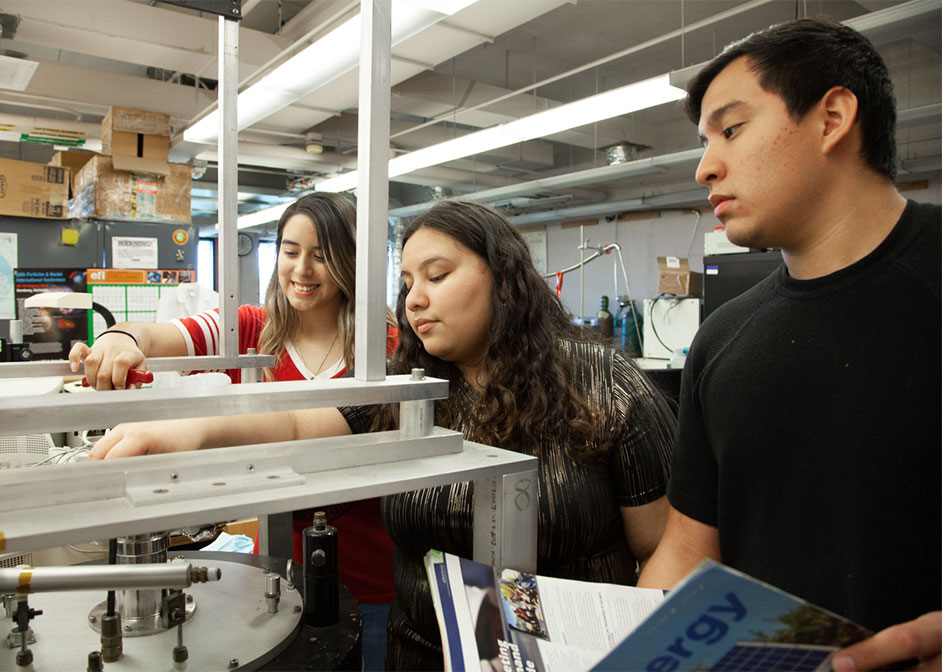UH Hosts Two-Year Pilot Program for Minority Physics Students
U.S. Department of Energy Awards Half a Million Dollars
Nine undergraduate students spent the summer at University of Houston through the Nuclear Science in Texas to Enhance and Advance Minorities, or NuSTEAM, program.

The U.S. Department of Energy’s Office of Science awarded a two-year, $500,000 grant to UH, University of Texas at El Paso (UTEP), University of Texas Rio Grande Valley (UTRGV) and Prairie View A&M University to enhance participation of Black and Hispanic students in nuclear physics and high energy physics. UH received $199,000, and the other three collaborating institutions divided $301,000.
“Unfortunately, Hispanic and African American students are a very small fraction of the community of high-energy and nuclear physics,” said Claudia Ratti, associate professor of physics at UH’s College of Natural Sciences and Mathematics and principal investigator of the grant.
“The idea is to try to enhance their participation and to help them advance in these fields. This doesn’t mean that after this program they must become an academic. They will learn techniques and skills they can apply to industry and to research.”
Ratti adds that she and her co-principal investigators at UH and participating institutions are providing a set of skills under the general umbrella of nuclear and high-energy physics, which also involves computer programming and data analysis.
UH Physics Ph.D. graduate Israel Portillo is the program coordinator. “Just two years ago I was a student, and now I am able to teach students lectures, serve as a role model for them,” he said.
Eight-Week Exposure: Nuclear and High-Energy Physics
Three undergraduate students from UH and two undergraduate students from each respective institution participated in NuSTEAM. Their six weeks at UH included morning lectures from participating faculty and afternoon problem-solving exercise sessions.
“I feel like this program is basically setting the path to make it easier for you to do whatever you want in the field,” said Jocelyn Rich, a senior physics major at UTRGV.
She added, “The experience has been good. I’m far away from home. I thought I was going to be homesick in the beginning, but it’s been a great experience. I am planning on becoming a nuclear physicist, so this is a great opportunity for my career.”
For another participant, the program revealed possible career paths.
“I’ve been able to learn about three different fields of physics – particle physics, nuclear physics and neutrinos – and how much you can do with a physics background,” said Bryan Gonzalez, a senior electrical engineering major at UTEP. “Because of this program, I started thinking about graduate programs. I really didn’t think about it before because I really didn’t see any advantages. For me personally, I could go into nuclear engineering.”
Following their time in Houston, the students had a two-week virtual experience with researchers at Brookhaven National Laboratory in New York.
Continued Research Experience
Once back at their home campuses, they will conduct undergraduate research for two semesters and be mentored by both a local co-principal investigator and one from UH.
“The nice thing is that they get paid for the research they do,” Ratti said.
The nine students received a 40-hours-a-week stipend for the six weeks spent at UH and the two-week Brookhaven experience. They will be paid 15 hours a week for their two semesters of undergraduate research.
Students were chosen based on their GPA and interest in nuclear and high-energy physics. Each applicant had to submit a letter of interest. All students this year are either Hispanic or Black.
Speaking from Personal Experience
For Ratti, applying for the grant was yet another opportunity to mentor non-traditional physics students. Coming from Italy, she said women make up a sizeable percentage of the physics community. When she went on to pursue a postdoctoral fellowship outside of Italy, she encountered a cultural shift.
“When I was a postdoc abroad, before joining the UH physics department, I was often the only woman in the group,” she said. “I was almost the only woman in the department. I felt intimidated. This was an environment where I did not feel welcome. Comparing the two experiences, it was so much nicer when I had a group of people like me around.”
That is why she is leading a program to advance minorities and increase their percentage, so they feel welcome and have role models to follow.
Participating Faculty
Co-principal investigators at UH are M.D. Anderson Chair Professor Rene Bellwied, assistant professor Daniel Cherdack, Moores Professor Lawrence Pinsky and associate professor Anthony Timmins.
Co-principal investigators at participating institutions are Jorge Munoz, assistant professor of physics at UTEP, Vivian Incera and Efrain Ferrer, professors of physics at UTRGV, and Premkumar Saganti and Gary Erickson, professors of physics at Prairie View A&M.
Rebeca Trejo, College of Natural Sciences and Mathematics

